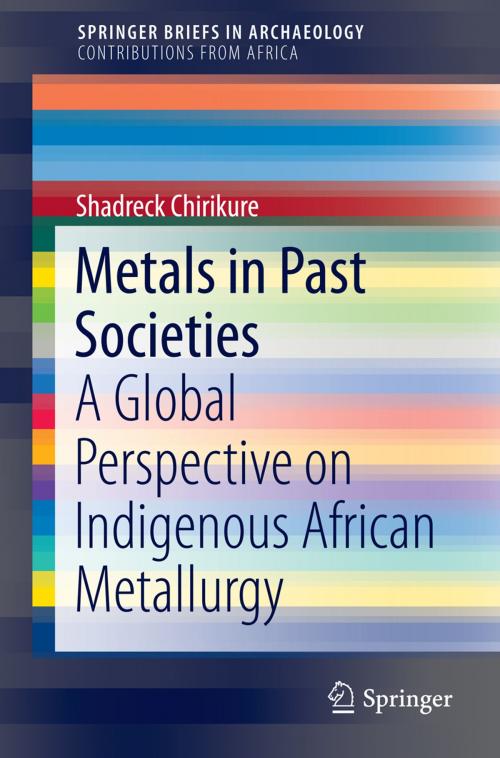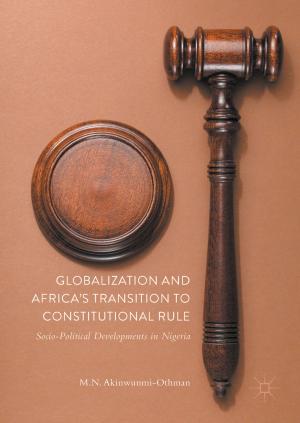Metals in Past Societies
A Global Perspective on Indigenous African Metallurgy
Nonfiction, Social & Cultural Studies, Social Science, Archaeology, Anthropology, History| Author: | Shadreck Chirikure | ISBN: | 9783319116419 |
| Publisher: | Springer International Publishing | Publication: | March 18, 2015 |
| Imprint: | Springer | Language: | English |
| Author: | Shadreck Chirikure |
| ISBN: | 9783319116419 |
| Publisher: | Springer International Publishing |
| Publication: | March 18, 2015 |
| Imprint: | Springer |
| Language: | English |
This book seeks to communicate to both a global and local audience, the key attributes of pre-industrial African metallurgy such as technological variation across space and time, methods of mining and extractive metallurgy and the fabrication of metal objects. These processes were transformative in a physical and metaphoric sense, which made them total social facts. Because the production and use of metals was an accretion of various categories of practice, a chaine operatoire conceptual and theoretical framework that simultaneously considers the embedded technological and anthropological factors was used.
The book focuses on Africa’s different regions as roughly defined by cultural geography. On the one hand there is North Africa, Egypt, the Egyptian Sudan, and the Horn of Africa which share cultural inheritances with the Middle East and on the other is Africa south of the Sahara and the Sudan which despite interacting with the former is remarkably different in terms of technological practice. For example, not only is the timing of metallurgy different but so is the infrastructure for working metals and the associated symbolic and sociological factors. The cultural valuation of metals and the social positions of metal workers were different too although there is evidence of some values transfer and multi-directional technological cross borrowing. The multitude of permutations associated with metals production and use amply demonstrates that metals participated in the production and reproduction of society.
Despite huge temporal and spatial differences there are so many common factors between African metallurgy and that of other regions of the world. For example, the role of magic and ritual in metal working is almost universal be it in Bolivia, Nepal, Malawi, Timna, Togo or Zimbabwe. Similarly, techniques of mining were constrained by the underlying geology but this should not in any way suggest that Africa’s metallurgy was derivative or that the continent had no initiative. Rather it demonstrates that when confronted with similar challenges, humanity in different regions of the world responded to identical challenges in predictable ways mediated as mediated by the prevailing cultural context.
The success of the use of historical and ethnographic data in understanding variation and improvisation in African metallurgical practices flags the potential utility of these sources in Asia, Latin America and Europe. Some nuance is however needed because it is simply naïve to assume that everything depicted in the history or ethnography has a parallel in the past and vice versa. Rather, the confluence of archaeology, history and ethnography becomes a pedestal for dialogue between different sources, subjects and ideas that is important for broadening our knowledge of global categories of metallurgical practice.
This book seeks to communicate to both a global and local audience, the key attributes of pre-industrial African metallurgy such as technological variation across space and time, methods of mining and extractive metallurgy and the fabrication of metal objects. These processes were transformative in a physical and metaphoric sense, which made them total social facts. Because the production and use of metals was an accretion of various categories of practice, a chaine operatoire conceptual and theoretical framework that simultaneously considers the embedded technological and anthropological factors was used.
The book focuses on Africa’s different regions as roughly defined by cultural geography. On the one hand there is North Africa, Egypt, the Egyptian Sudan, and the Horn of Africa which share cultural inheritances with the Middle East and on the other is Africa south of the Sahara and the Sudan which despite interacting with the former is remarkably different in terms of technological practice. For example, not only is the timing of metallurgy different but so is the infrastructure for working metals and the associated symbolic and sociological factors. The cultural valuation of metals and the social positions of metal workers were different too although there is evidence of some values transfer and multi-directional technological cross borrowing. The multitude of permutations associated with metals production and use amply demonstrates that metals participated in the production and reproduction of society.
Despite huge temporal and spatial differences there are so many common factors between African metallurgy and that of other regions of the world. For example, the role of magic and ritual in metal working is almost universal be it in Bolivia, Nepal, Malawi, Timna, Togo or Zimbabwe. Similarly, techniques of mining were constrained by the underlying geology but this should not in any way suggest that Africa’s metallurgy was derivative or that the continent had no initiative. Rather it demonstrates that when confronted with similar challenges, humanity in different regions of the world responded to identical challenges in predictable ways mediated as mediated by the prevailing cultural context.
The success of the use of historical and ethnographic data in understanding variation and improvisation in African metallurgical practices flags the potential utility of these sources in Asia, Latin America and Europe. Some nuance is however needed because it is simply naïve to assume that everything depicted in the history or ethnography has a parallel in the past and vice versa. Rather, the confluence of archaeology, history and ethnography becomes a pedestal for dialogue between different sources, subjects and ideas that is important for broadening our knowledge of global categories of metallurgical practice.















